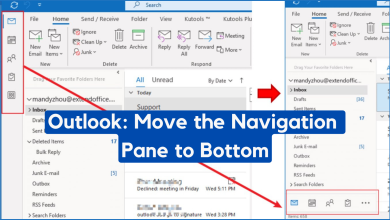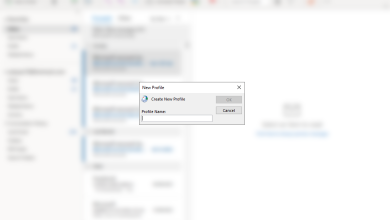Fix: Outlook Error 0x8004060c
Outlook error 0x8004060c occurs because the PST file has reached its size limit, there is a corrupted PST file, Sync Issues in cached mode and an outdated Outlook. There could be diverse error 0x8004060C messages that can appear in this particular problem but all result in no incoming and outgoing email using the Outlook client.

What Causes Outlook Error 0x8004060c?
- Maximum Size of PST file has reached: PST file is the backbone of Outlook communication. If your PST file has reached its maximum size then it can cause the 0x8004060c error.
- Corrupted PST/OST file: If PST/OST files hold different types of important Outlook data and if these files are corrupt, then it can force the Outlook to show the current issue.
- Sync Issues in Cached Mode: In the Cached mode Outlook keeps a local copy of the user’s data. If Outlook in the cached mode is facing sync issues with the Microsoft Exchange Server, then it can result in the error in hand.
- Outdated Outlook: Microsoft adds new features and improvements to Outlook by releasing updates for it. If your version of Outlook is outdated then you are likely to face many types of problems.
1. Compact the PST file
Outlook reduces the size of PST files by compacting it. When an email is deleted, the background process ensures that the file size of PST is also corrected by compacting it. The process of compacting can be initiated manually, however, offline Outlook Data File (.ost) could not be compacted.
- Open Outlook and then click on the File
- Then in Info click on the Account Settings and in the drop-down list click on Account Settings.
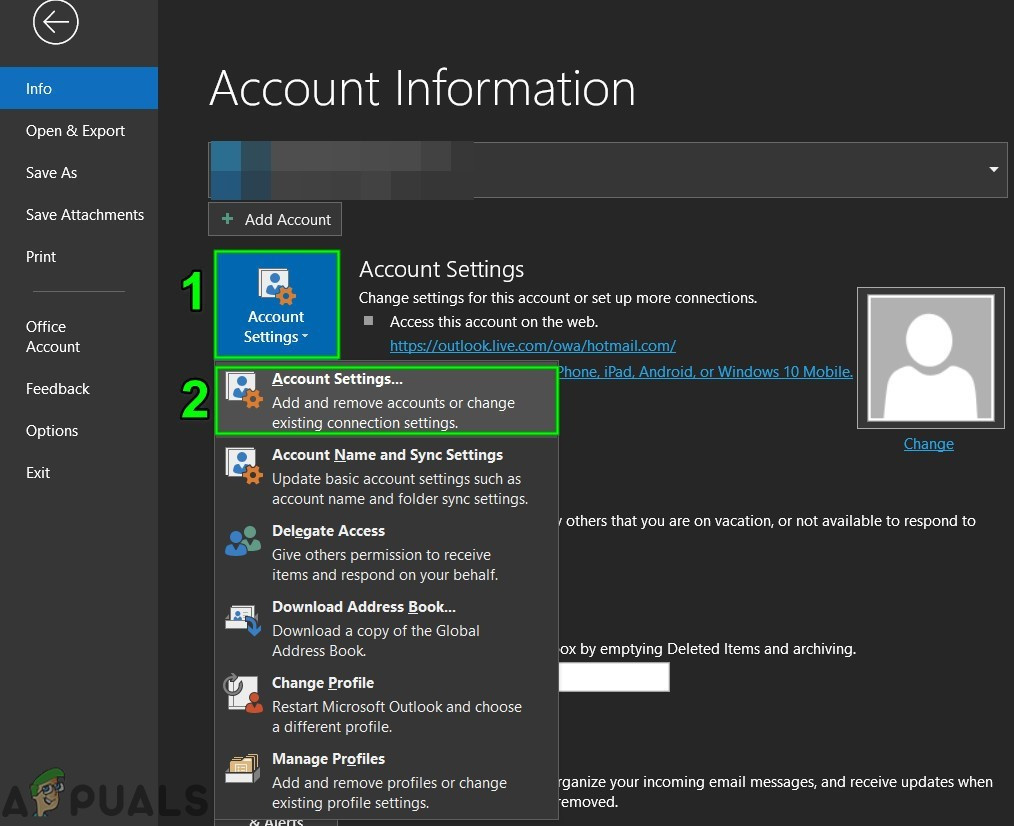
Account Settings of Outlook - Now in the Account Settings window, click on Data File.
- Now select the PST file that you want to compact and then click on Settings.
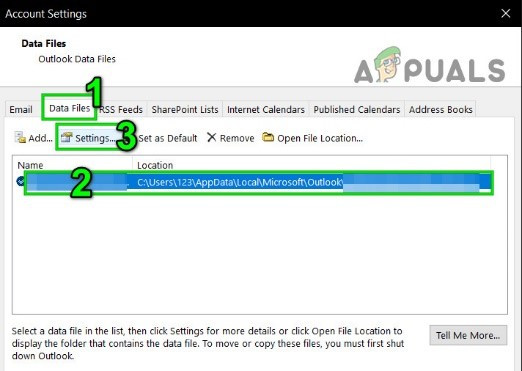
Settings of PST File - Click on the Advanced tab and then click on Outlook Data File Settings.

Open Outlook Data File Settings - Press the Compact Now button on the Outlook Data File window.
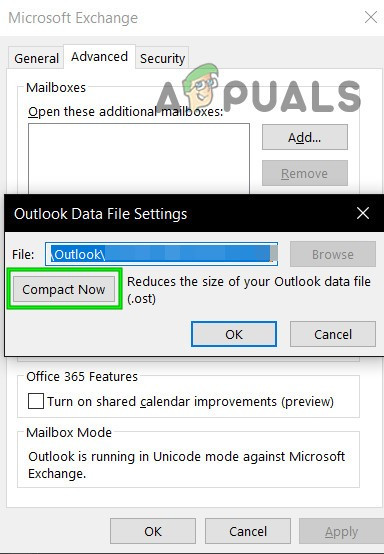
Compact Now of Outlook Data File - Close the Outlook then Reopen Outlook and check if it has started to operate normally.
2. Update Outlook/Office
Microsoft releases frequent updates for its products for improvement in features and to keep these products bug free and Outlook is not an exception. If the current error of Outlook is due to a known bug that Microsoft has already patched in its Updates, then updating Outlook/Office to the latest version may solve the problem.
- Open Outlook and then click on the File tab.
- Click on the Office account option and then click on the Update Options button.
- Now in the drop-down list, click on the Update Now for updating the software.
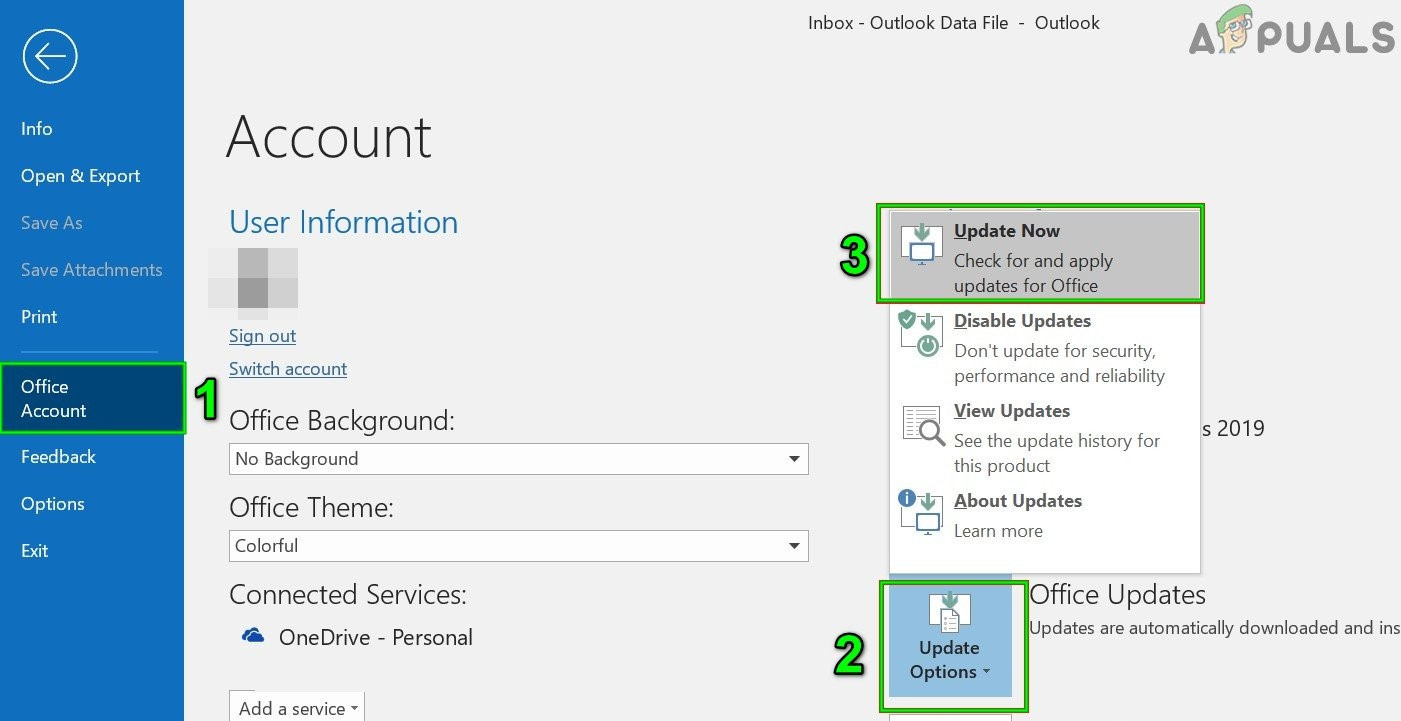
Run Update Now of Outlook - After updating, restart Outlook and check if it has started to function without any error.
3. Use Online Mode
Outlook has two modes, Online Mode and Cached Mode to connect with an Exchange Server. In the cached mode, Outlook keeps a copy of the user’s Exchange mailbox locally. So, if Outlook is having trouble in cached mode then it can force Outlook into Outlook error 0x8004060c. In that case, changing the connection mode from Cached to Online may solve the problem.
- Open Outlook and click on File menu
- Now Click on the Account Settings drop-down menu and again click on Account Settings.

Run Update Now of Outlook - Now in the Email Tab, select your account and then click on Change.

Change Outlook Settings - Now in Exchange Account Settings, Click on More Settings.
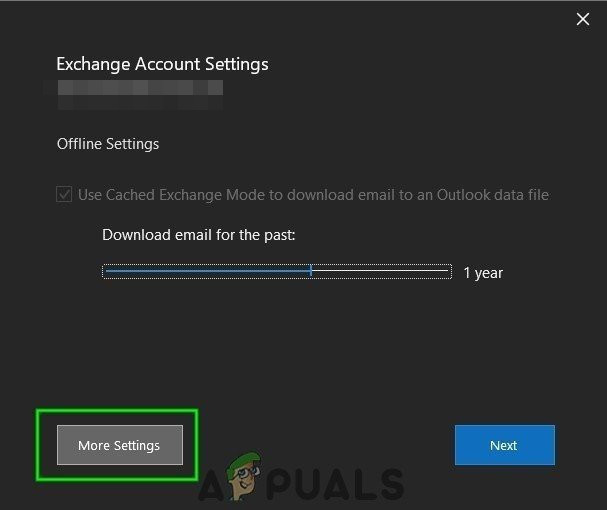
Open More Settings of Outlook - Now click on Advanced tab and then Uncheck “Use Cached Exchange Mode”
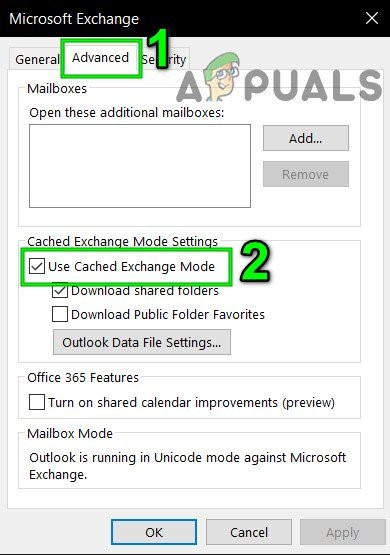
Uncheck Use Cached Mode - Now restart Outlook and check if it has started to function properly.
4. Repair Outlook’s PST File
When you Send/Receive operation is performed in Outlook then it uses the user’s folders for the attachments and email message. Outlook has the “.pst” file for this purpose, which can be stored locally on the system or a server if you are on a corporate network. If the .pst file is corrupted, then it can force Outlook error 0x8004060c. Luckily, Microsoft has included a utility “SCANPST.EXE” which can fix .pst file and thus may solve the problem.
- Exit Outlook.
- Click the Windows button and then in the search box type Outlook and in the results displayed, Right-click on Outlook and then click on “Open File Location”.
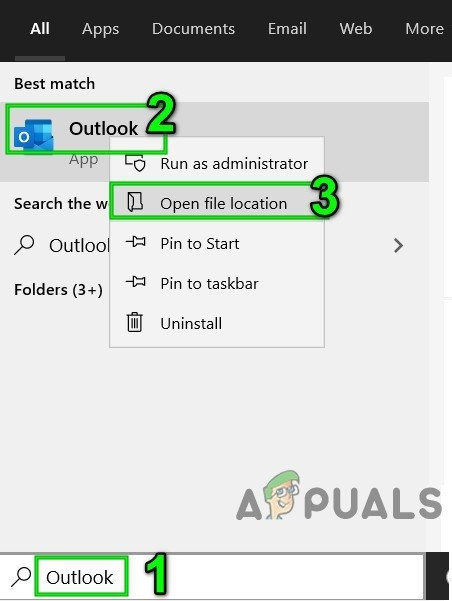
Open Outlook File Location from Windows Search - The following folder will be opened that holds shortcuts of programs.
C:\ProgramData\Microsoft\Windows\Start Menu\Programs
- In this program folder, Right-click on the Outlook icon and then click on the “Open File Location”.

Open File Location from File Explorer - The following folder will be opened.
C:\Program Files (x86)\Microsoft Office\root\Office16
- Now in Office 16 folder, locate SCANPST.EXE file and then right-click on it and click on “Run as Administrator”.

Run ScanPST as Administrator - Press the Browse button in Microsoft Outlook Inbox Repair.

Microsoft Outlook Inbox Repair - Then select the problematic PST file. (Location of the PST file is explained at end of these steps).
- Now Click on the Start button to initiate scanning.
- If prompted, then click on Repair to fix the issues with the file.
- Restart Outlook and check if it is functioning without any problem.
The location of the .pst file depends on various factors like on the version of Outlook, version of Windows, and how the user’s account is set up. Following are default locations of your .pst file as per the OS:
- Windows 10
drive:\Users\<username>\AppData\Local\Microsoft\Outlook
drive:\Users\<username>\Roaming\Local\Microsoft\Outlook
- Older Windows Version
drive:\Documents and Settings\<username>\Local Settings\Application Data\Microsoft\Outlook
5. Empty the “Deleted Items” Folder
As the problem is storage size related, and your overloaded Deleted items folder can be occupying a lot of share from total Outlook file storage capacity. In that case, emptying the Deleted items folders may solve the problem.
- Open Outlook, and in the left pane of Outlook Window, Right-click on Deleted Items folder.
- In the resulting menu, click on Empty Folder to empty the folder
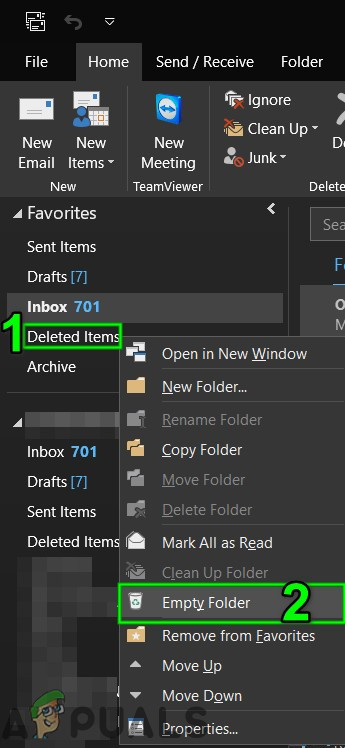
Empty Deleted Items Folder - Close Outlook then reopen it and check if Outlook has started to function without any issue.
To empty this folder automatically, follow the steps below:
- In the Outlook window, click on the File tab and then click on Options.
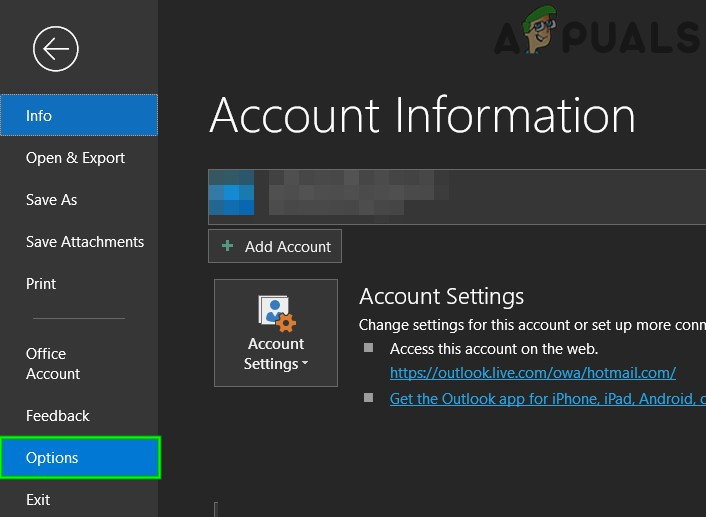
Open Outlook Options - Now in the left side of the window click on Advanced and then in the right pane of the window find Outlook start and exit section and then check the checkbox of ‘Empty Deleted Items folders while exiting Outlook’
- Click OK to save the changes.
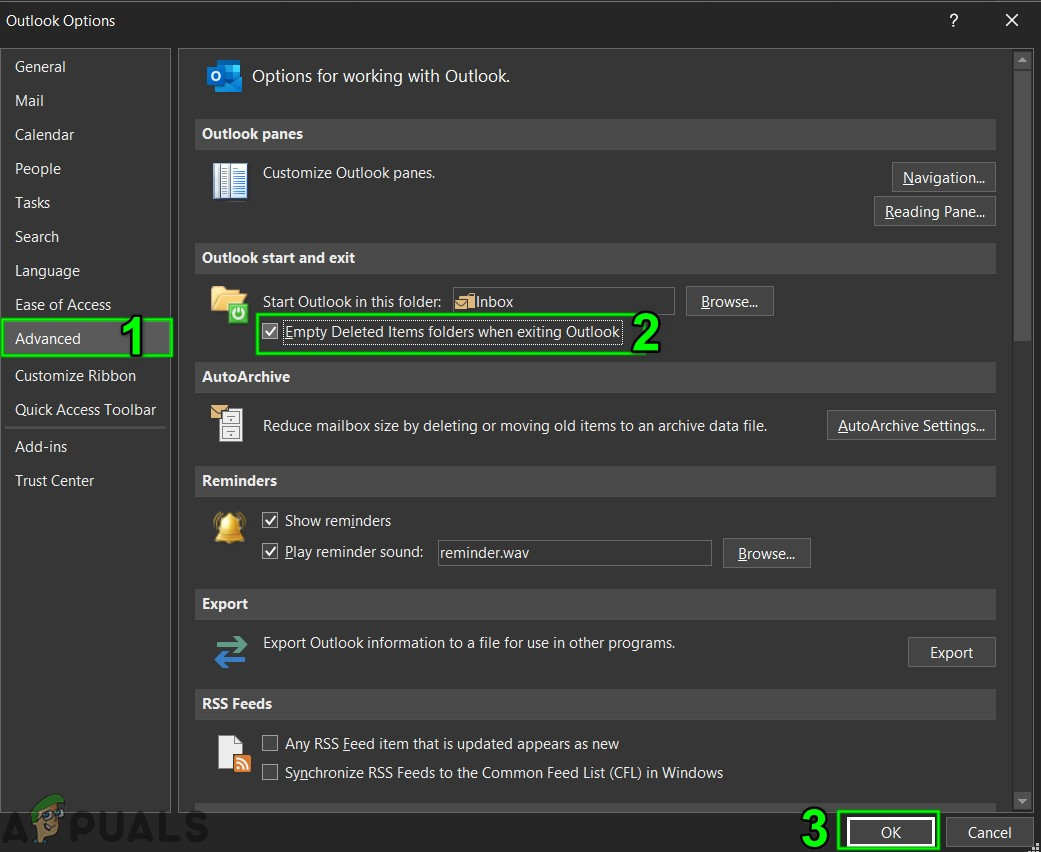
Empty Deleted Items Folder When Exiting Outlook
6. Delete Unnecessary Emails
There could be a lot of junk emails accumulated over time and these emails will be taking a large portion of the size of Outlook data file.
Also, by default, a copy of every email that you forward to your associate resides in your Inbox and your Sent Items folder. In this way, the copied emails occupy unnecessary Outlook space.
So, removing unnecessary emails and deleting the copied forwarded emails may solve the problem.
- Open Outlook and click on Sent Items.

Open Sent Items Folder - Now in the Sent Items, Click on By Date Filter and Select “To” filter emails by recipients.

Filter Sent Mails by To - Now delete all the duplicate, unwanted, unnecessary emails or attachments (that you no longer need) from your mailbox. To do that, hold the Ctrl key and select multiple emails. Then press the Delete button to erase them.
- Relaunch Outlook and check if it has started to function normally.
To stop saving a copy of the forwarded message automatically follow the instructions below:
- Open Outlook then click on the File tab and then select Options
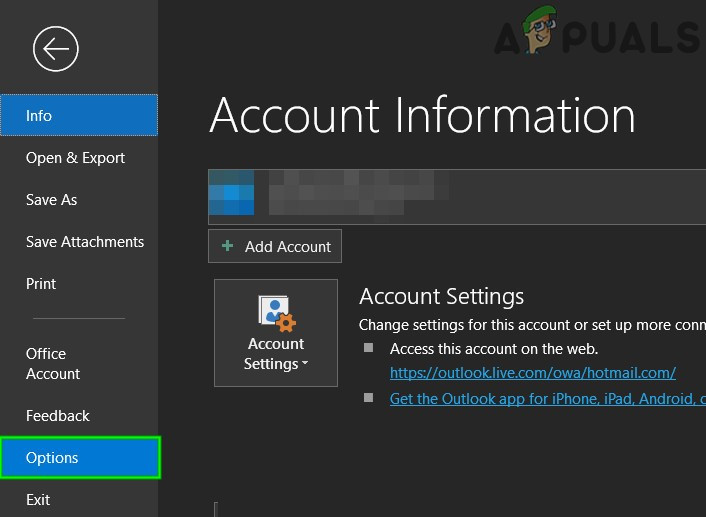
Open Outlook Options - Now click on the Mail and in the Save Message section, uncheck the option ‘Save forwarded messages’
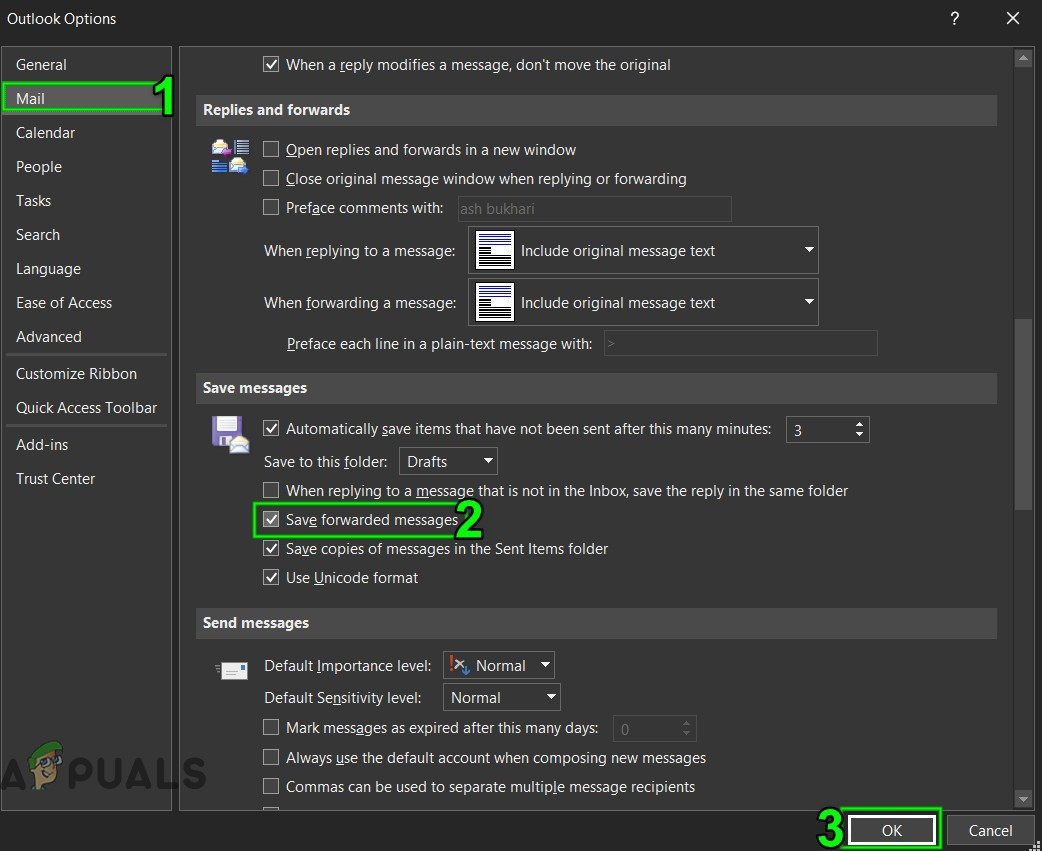
Uncheck Save Forwarded Messages - Click OK to save the changes.
7. Run Mailbox Cleanup Tool
As the issue is storage size-related, Outlook has a built-in utility Mailbox Cleanup which can help figure out large size emails easy. And thus, may solve the problem.
- Click on the File tab and in the Info tab click on Tools.
- In the drop-down list, click on Mailbox Cleanup.
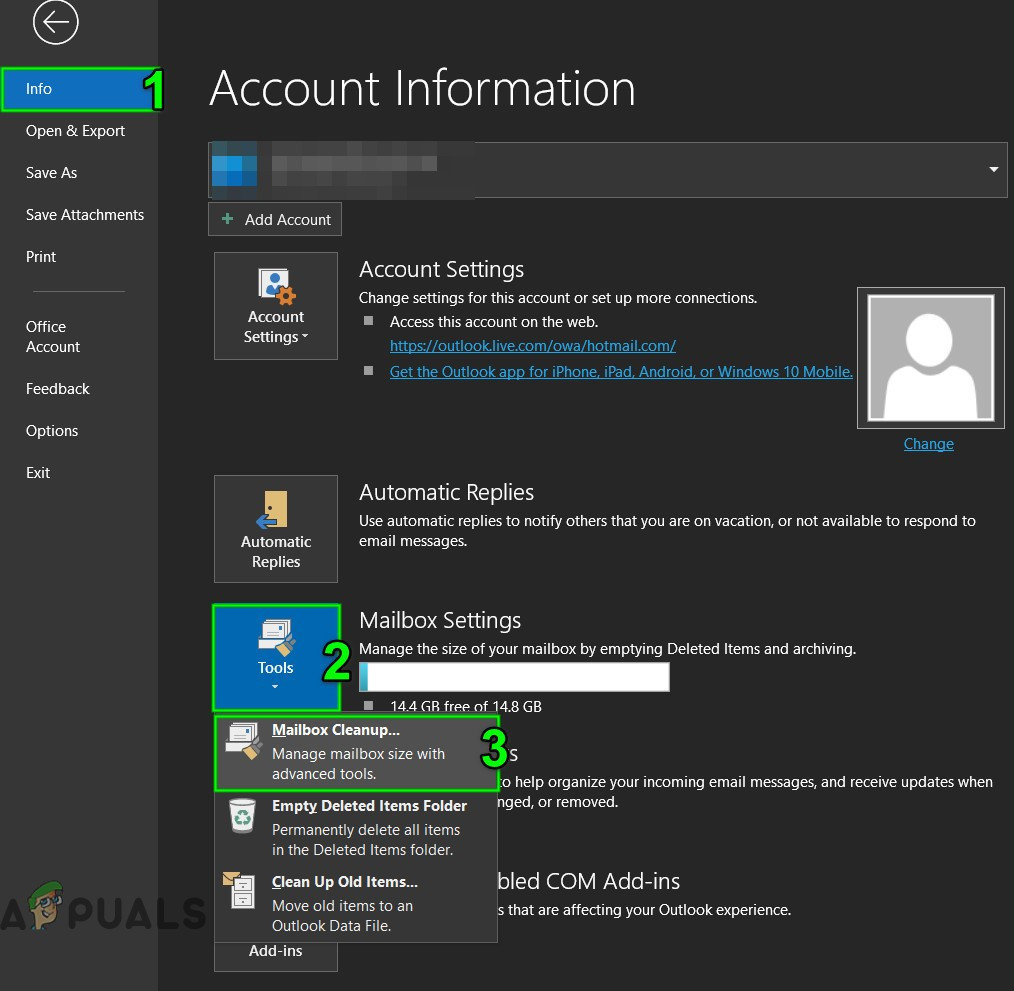
Mailbox Cleanup Tool - Here you can manage individual Mailbox Size, find old emails, empty deleted items folder and remove all the alternate versions of items in your mailbox.

Manage Mailbox Cleanup - Now relaunch Outlook and check if it has started to function correctly.
8. Use Outlook Import/Export
Import/Export wizard is a built-in Outlook utility to move data files to and from MS Outlook. We can use this utility to split the PST file into smaller files in MS Outlook which will decrease the size of the PST file and thus may solve the problem.
- Launch MS Outlook, click the File
- Now in Info click on Account Settings and then in the drop-down list click on Account Settings.

Account Settings of Outlook - Click on the Data Files tab and then click on the Add
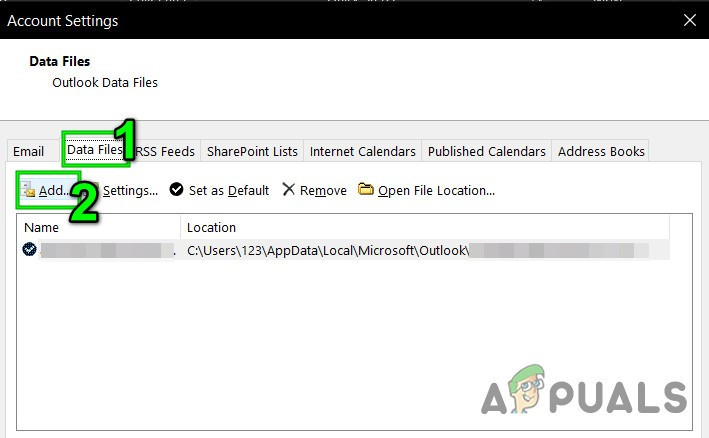
Add New Data File - Now enter a name and type as Outlook data file (.pst)and click OK to create a new PST.
- Now you can view the new PST under Data Files. Close the Account Settings windows.
- Now in the Outlook main window, click the File tab and then click on Open & Export.
- Now click on Import/Export.
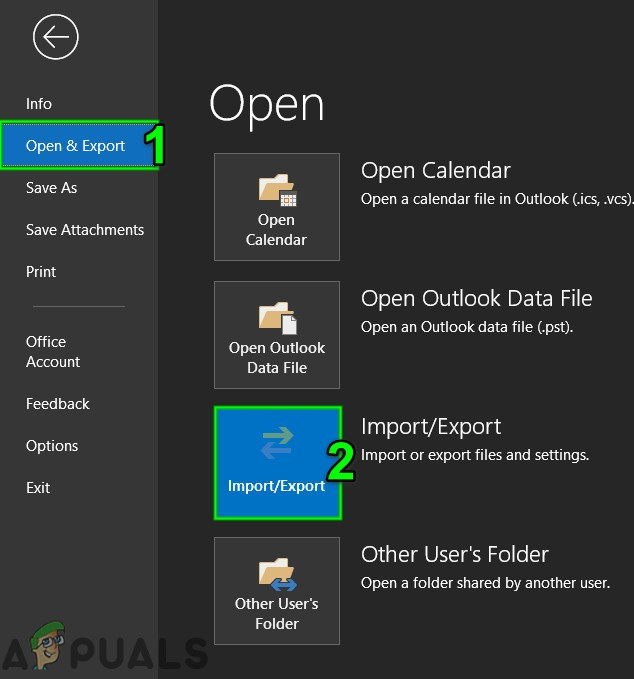
Import Export Outlook - Now in Import and Export Wizard, choose Export a File and then click on the Next.
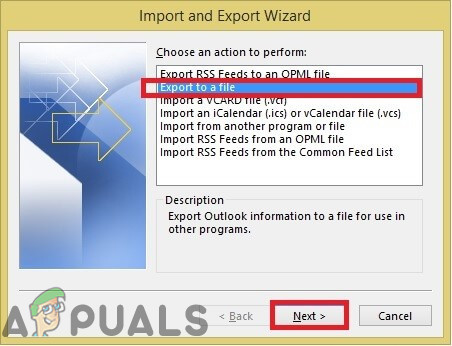
Export to a File in Import and Export Wizard - Now in Export File window, select Outlook Data File (.pst) and click Next.
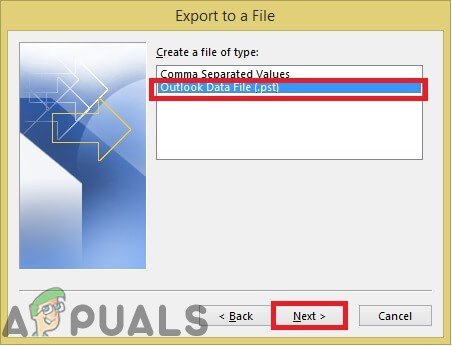
Export to Outlook Data File PST - Choose folders to export and check the Include Subfolders option if you want to export subfolders.
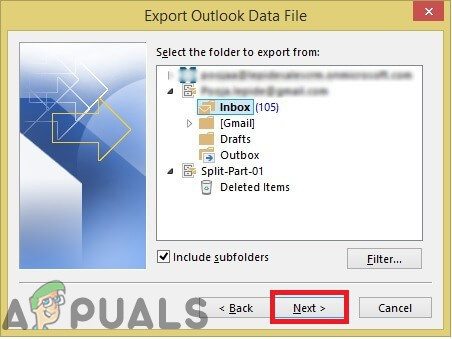
Select Folders to Export - Now, browse to select the saving location of the exported file and choose from options to disallow exporting duplicates items. And, click Finish.
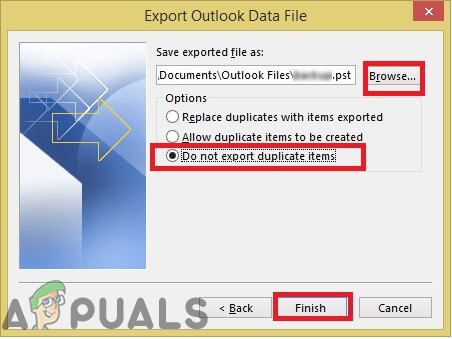
Do Not Export Duplicate Items - If you want to, you can set up a password for the exported PST file.
- Now delete the exported folders from the main PST file to reduce its size and check if Outlook is clear of the Outlook error 0x8004060c.
9. Use Move to Folder Option
Outlook’s Move to the Folder option is quite helpful when moving data between Outlook folders. We can use the same functionality to move data from one PST file to another which will decrease the size of the PST file and thus may solve the problem.
- Launch Outlook and then click on the File
- Now click on Account Settings and then in the drop-down list click on the Account Settings.
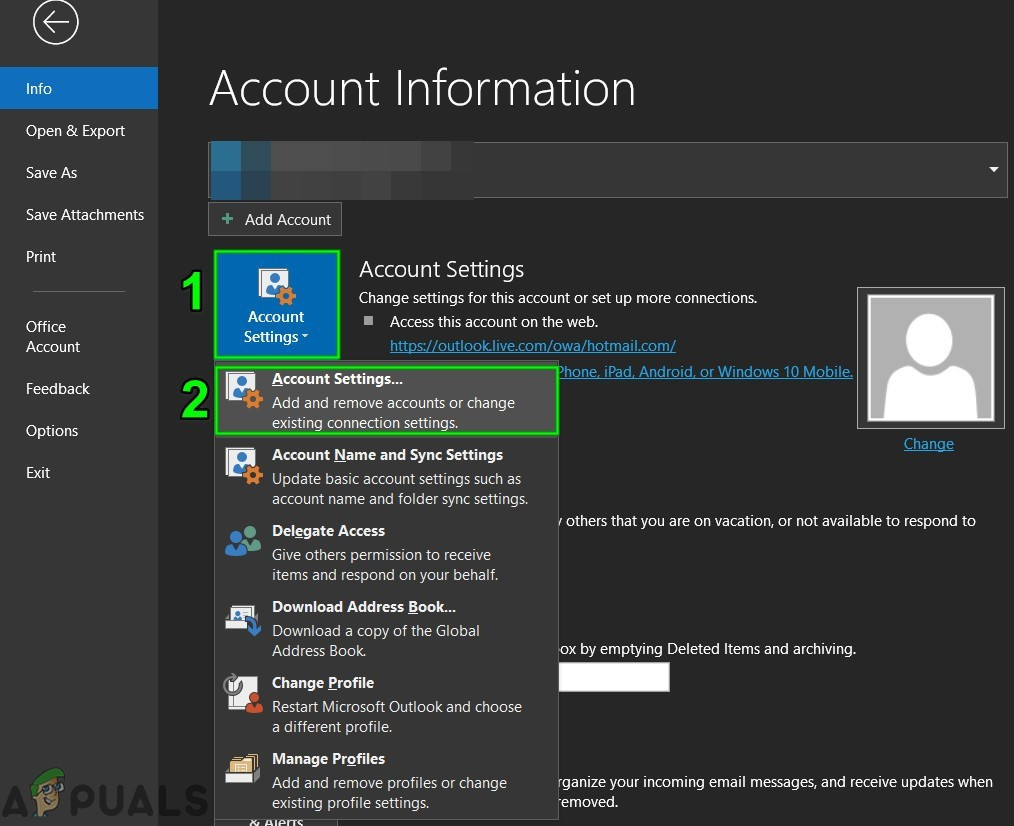
Open Outlook Account Settings - Now in the Account Settings window, click on Data Files and then on the Add.
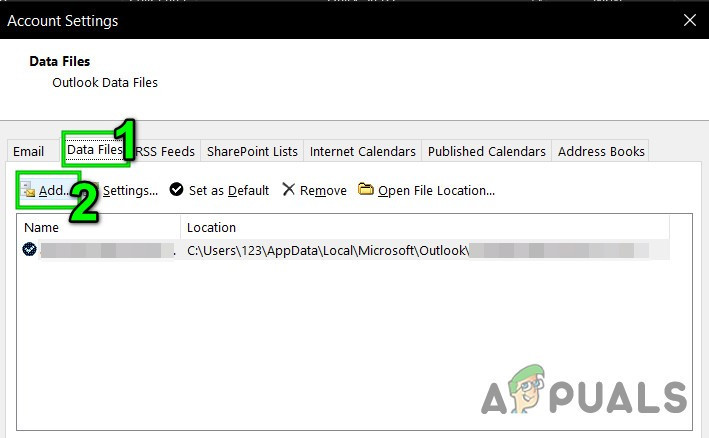
Add New Data File in Outlook - Now enter a name and type as Outlook data file (.pst)and click OK to create a new PST.
- Now the new PST file will be shown under Data Files. Close the Account Settings windows.
- Go to the Home tab of Outlook and open the default PST file of your Outlook profile and select the items you want to move to a new PST file you created in the previous step.
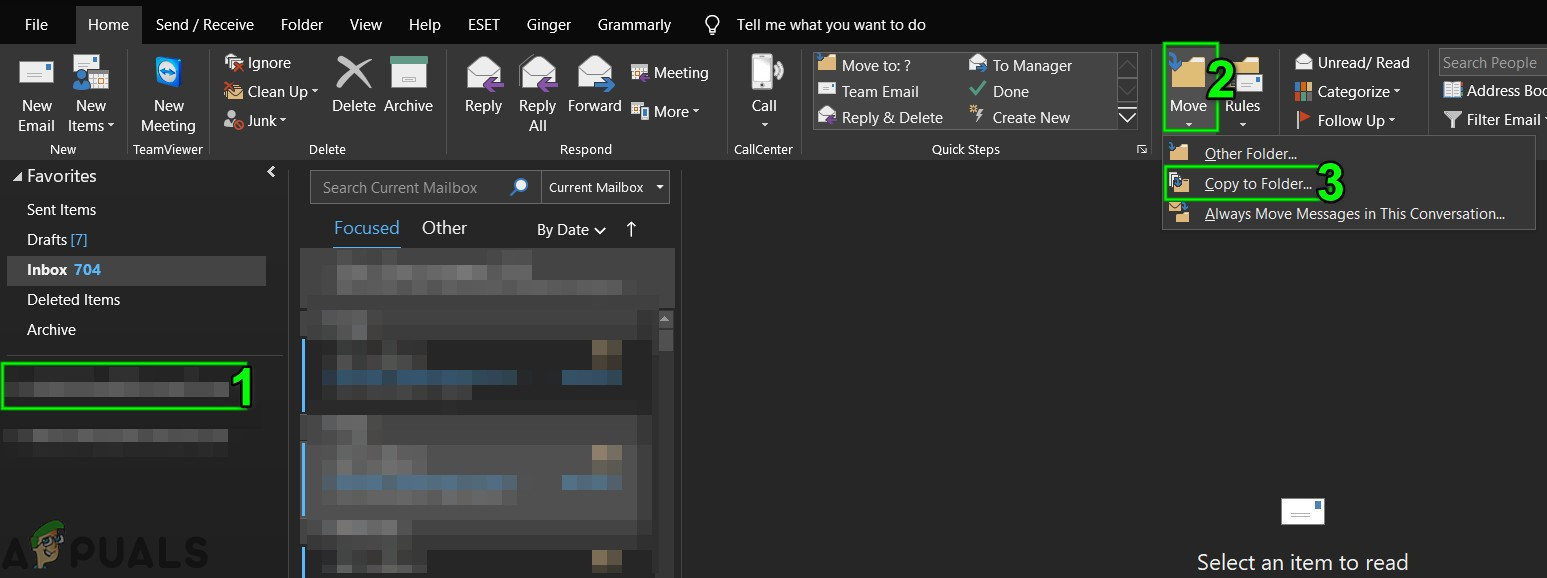
Copy to Folder - Choose the PST file, so that all the selected data items from the default PST file can be moved to the new PST file.
- Now delete the copied items from the default PST file so that its size gets reduced.
- Relaunch Outlook and check if it is functioning normally.
10. Use Outlook Archive Wizard
Emails get accumulated over time and usually, the user wants to keep them as a record. With the archiving technique, the size of the PST file can be reduced and older data items are saved to the desired location one by one within Outlook and can be used when required. In that case, using the Outlook Archive Wizard may solve the problem.
- Start MS Outlook and click on File tab
- Then in the Info, click on Tools and then click on Clean Up Old Items.
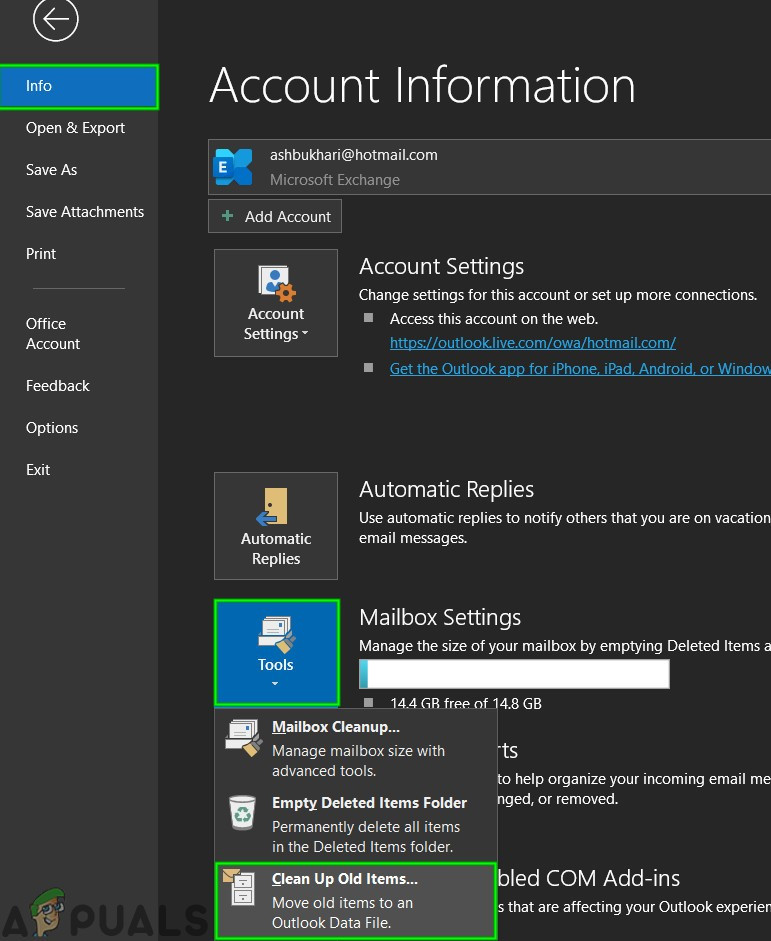
Clean Up Old Items - Now select a folder to Archive, choose a date to Archive older items and click Browse to save the Archive file to the desired location.
- Relaunch Outlook and if it is working fine.
11. Create a New Outlook Data File
Outlook uses different types of files to hold different types of data. The data file of Outlook holds key components for Outlook. If the current Outlook data file has corrupted then it can force the Outlook error 0x8004060c. In that case, creating a new Outlook data file and using it as default may solve the problem.
- Open Outlook and on the Home tab click on New Items.
- In the drop-down list click on More Items and in the sub-menu click on Outlook Data File.

Create a New Outlook Data File - Enter the name of the file.
- If you want to use a password (if you set a password, you must enter it every time that the data file is opened e.g. when Outlook starts or when you open the data file in Outlook), then check the Add Optional Password and Type a password in both the Password and Verify Password text boxes and select OK.
- After creating the new data file, open Outlook and click on File tab,
- And then click on Account Settings and in the drop-down list click on the Account Settings.
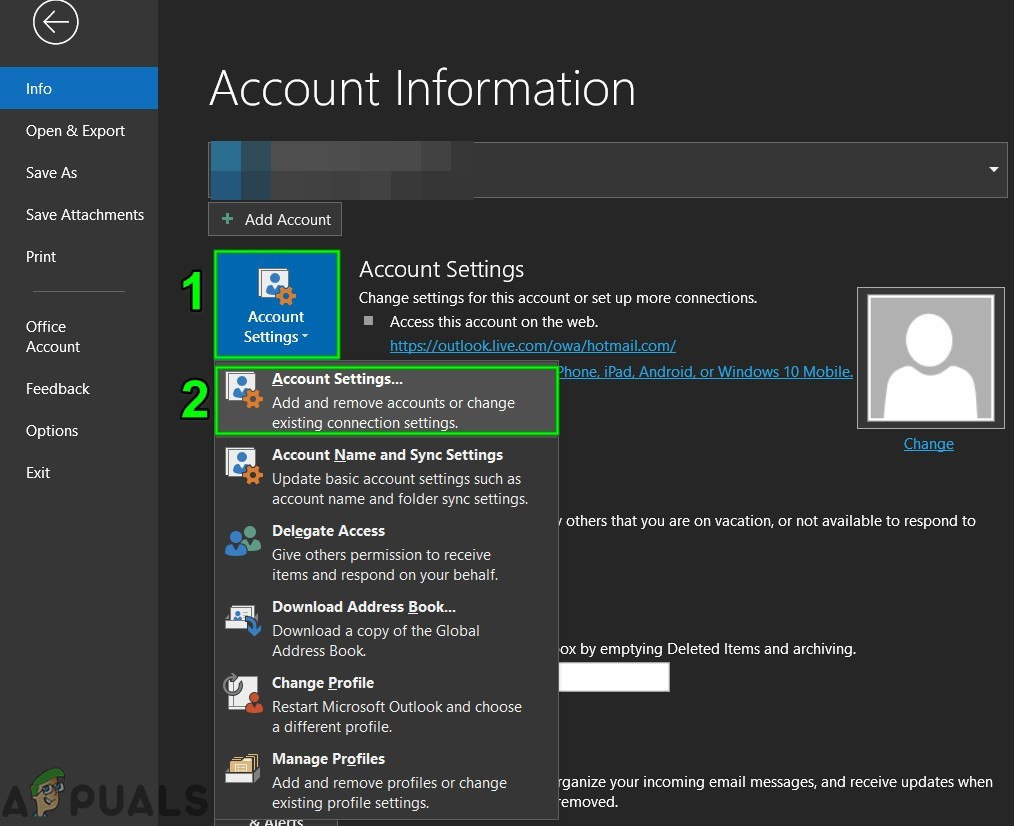
Open Outlook Account Settings - Now click on the Data Files tab and select the newly created Outlook data file and then click on the Set as Default.

Set Outlook Data File as Default - Now Restart Outlook and check if outlook has started to function properly.
12. Increase Maximum Storage Size of Outlook PST File
Microsoft has limited the maximum size a PST file can hold and when this size limit is reached it can force Outlook error 0x8004060c. This limit can be increased by using Registry Editor and thus may solve the problem.
Warning: Extreme caution be taken while making changes in Registry as it needs expertise and follow guidelines strictly as mentioned because any wrongdoings may corrupt the entire OS.
- Exit Outlook.
- Press the Windows button and type Registry Editor and in the resulting list, Right-click on the Registry Editor and then click on Run as Administrator.
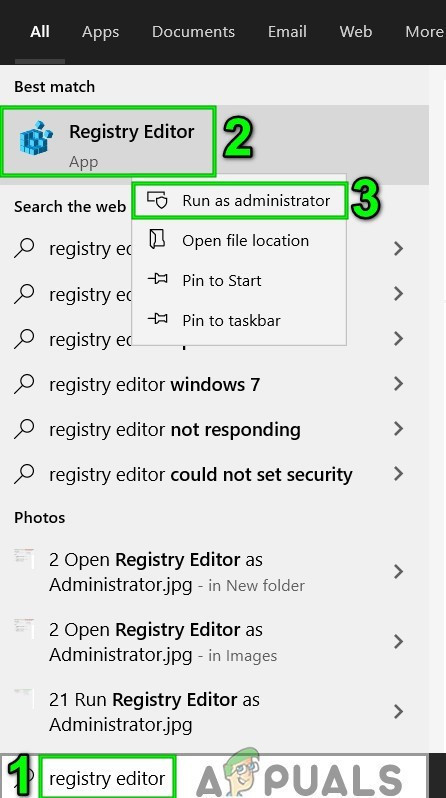
Open Registry Editor as Administrator - Now in Registry Editor, navigate to the limit settings for Outlook which depends upon your version of Outlook as mentioned below:
- Outlook 2016, 2019 & 365:
HKEY_CURRENT_USER\Software\Microsoft\Office\16.0\Outlook\PST
- Outlook 2013:
HKEY_CURRENT_USER\Software\Microsoft\Office\15.0\Outlook\PST
- Outlook 2010:
HKEY_CURRENT_USER\Software\Microsoft\Office\14.0\Outlook\PST
- Outlook 2007:
HKEY_CURRENT_USER\Software\Microsoft\Office\12.0\Outlook\PST
- Outlook 2003:
HKEY_CURRENT_USER\Software\Microsoft\Office\11.0\Outlook\PST
- Right-click on the right pane, and create two DWORD

Create New DWORD Key - MaxLargeFileSize: It is the maximum file size of the PST file
- WarnLargeFileSize: Warning message when the file size of the PST file reaches a certain limit.

Add Registry Values - Double click to open MaxLargeFileSize value and Select Decimal.
- Then at the Value data: box type the new maximum size limit (You need to enter the value in terms of MB) for the Outlook message store (PST file) according to the following:
- For the Outlook 2003 & 2007: Default message store maximum limit is 20GB, specify a size over 20GB.
- For the Outlook 2010, 2013, 2016, 2019 and Office 365: Default message store maximum limit is 50GB, specify a size over 50GB.
- For example. If you are using Outlook 2019 which has the maximum size limit of 50GB. In that case, you should specify a size greater than 80GB. To achieve this, you have to enter the number “81920”(without the quotes) in the Value data box.

- Select Ok.
- Then double click to open the WarnLargeFileSize value and Select Decimal.
- Now at the Value data: box type the new warning size limit (You need to enter the value in terms of MB) for the Outlook message store (PST file) according to the following:
- The Warning size should be 95% of the MaxLargeFileSize value you entered before.
- For example: If MaxLargeFileSize value was”81920″ at , then the WarnLargeFileSize value would be: 81920 X 95% = 77824

- Select Ok.
- Close Registry Editor.
- Restart the System and then launch Outlook and check if Outlook has started to function properly.
13. Run Microsoft Support and Recovery Assistant
The Microsoft Support and Recovery Assistant runs tests to figure out what’s wrong and offers the best solution for the identified problem. It can currently fix Outlook as well as Office/Office 365. If the Microsoft Support and Recovery Assistant can not fix a problem then it will suggest the next steps in troubleshooting the problem. So, running the Microsoft Support and Recovery Assistant may solve the problem.
- Download Microsoft Support and Recovery Assistant from Official Microsoft Website.

Microsoft Support and Recovery Assistant - Launch the downloaded file after completion of the download.
- Click I Agree to agree after reading & understanding the Microsoft Services Agreement.
- Choose the app you are having problems with, in this case, select Outlook and then click Next.
- Choose the problem you are facing having from the list and click Next.
- Follow the directions displayed by the Microsoft Support and Recovery Assistant provides.

